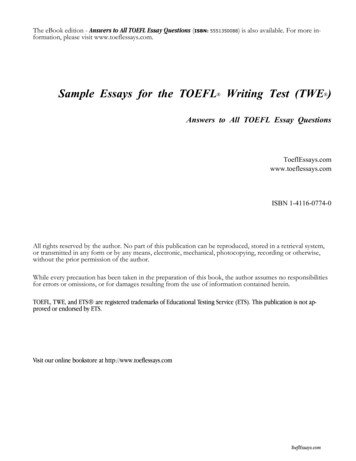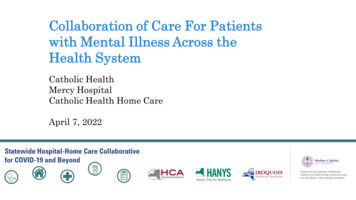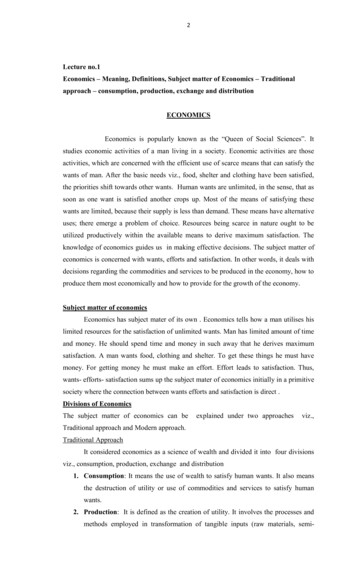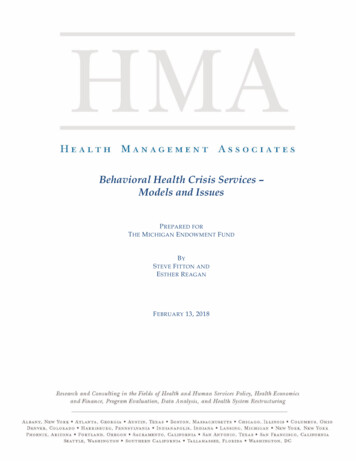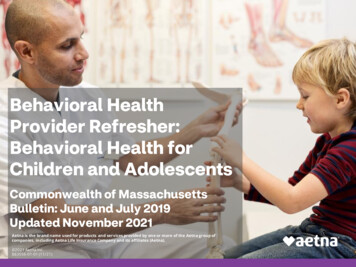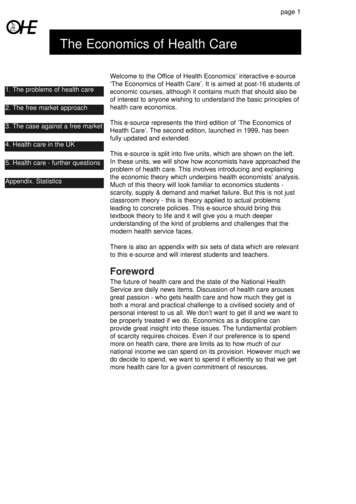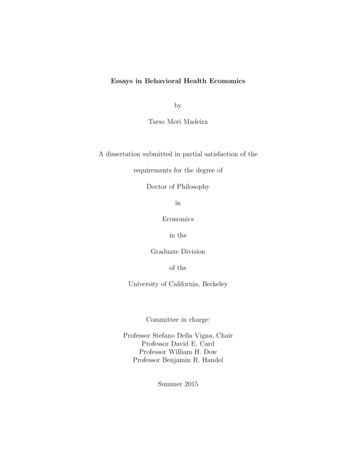
Transcription
Essays in Behavioral Health EconomicsbyTarso Mori MadeiraA dissertation submitted in partial satisfaction of therequirements for the degree ofDoctor of PhilosophyinEconomicsin theGraduate Divisionof theUniversity of California, BerkeleyCommittee in charge:Professor Stefano Della Vigna, ChairProfessor David E. CardProfessor William H. DowProfessor Benjamin R. HandelSummer 2015
Essays in Behavioral Health EconomicsCopyright 2015byTarso Mori Madeira
1AbstractEssays in Behavioral Health EconomicsbyTarso Mori MadeiraDoctor of Philosophy in EconomicsUniversity of California, BerkeleyProfessor Stefano Della Vigna, ChairThis dissertation is composed of two chapters. Each chapter presents a study testing atheory from behavioral economics in a health economics setting using field data.The first chapter studies the role of present bias in the choice of health insurance. Ianalyze the consequences of a policy change that removes deadlines for enrollment in highquality (5-star) Medicare drug coverage plans (Part D), while maintaining existing deadlinesfor enrollment in all other plans. Although the goals of the policy were to increase enrollment in 5-star plans and to provide incentives for insurers to improve quality, the removalof deadlines might lead to the opposite. First, rational beneficiaries might wait to enroll in5-star plans only when a negative health event occurs, which would both decrease enrollmentand increase adverse selection. Second, without deadlines, present-biased beneficiaries mightprocrastinate, which would also lead to a drop in enrollment, driven by an overall increasein inertia. I develop a model to examine these different hypotheses and test its predictionsusing Medicare administrative micro data for the period of 2009-2012. I employ a differencein-differences design within a differentiated-product discrete-choice demand framework. Myidentification strategy takes advantage of the fact that the policy did not actually changeenrollment rules everywhere in the United States, as most counties were not within the coverage area of a 5-star provider in 2012, the year the policy was implemented. I have threemain findings. First, the policy backfires: it decreases enrollment in the Part D programby 2.55pp from a baseline of 51.76%, and decreases average market share of 5-star plans by1.37pp from a baseline of 7.78%. Second, the policy does not seem to impact adverse selection, suggesting the rational model might not fully account for the results. Third, the removalof deadlines leads to a drop in the probability that a previously enrolled beneficiary switchesplans of 3.18pp (baseline 9.08%), suggesting that at least some Medicare beneficiaries arepresent-biased.The second chapter studies role of projection bias in mental health treatment decisions.Evidence from psychology suggests that on a bad-weather day, individuals may feel moredepressed than usual. If people are not fully able to account for the effect of transientweather, they may take systematically biased treatment decisions. I derive a model of a
2person considering treatment for depression and show that when projection bias is present,transient weather might influence choice. I use detailed administrative medical records fromthe MarketScan database and daily county-level meteorological data from the National Climatic Data Center. My period of analysis is 01/01/2003 through 12/31/2004. My mainanalysis focuses on patient behavior during a small interval of time after they have beenseen by a physician. I look at how weather influences antidepressant filling decision withinpatient and only include appointments that involved a major diagnosis of a mental disease ordisorder. I find that a one standard deviation increase in the amount of cloud coverage (2.73oktas) leads to a 0.063 percentage point increase in the probability that a patient fills anantidepressant prescription on appointment day. That is a 1.04% increase from the 6.07%baseline. I also find effects associated with snow, rain, and temperature. All effects fadewith time and are not significant within seven days of the appointment. Most of the impactof cloud coverage on antidepressant filling is due to an increase on the number of new prescriptions, not an increase in refills. Virtually all the effect happens at the pharmacy, notvia mail order. Most regions have similar coefficients associated with cloud coverage, withstronger results in the Northeast and Upper Midwest. Finally, most of the impact happensduring Winter.
iTo Emmanuel Large.
iiContentsContentsiiList of FiguresiiiList of Tablesiv1 The1.11.21.31.41.51.61.71.8Cost of Removing Deadlines: EvidenceIntroduction . . . . . . . . . . . . . . . . . .Background . . . . . . . . . . . . . . . . . .Theoretical Framework . . . . . . . . . . . .Data . . . . . . . . . . . . . . . . . . . . . .Effect on Enrollment . . . . . . . . . . . . .Effect on Adverse Selection . . . . . . . . .Effect on Inertia . . . . . . . . . . . . . . . .Discussion . . . . . . . . . . . . . . . . . . .from Medicare. . . . . . . . . . . . . . . . . . . . . . . . . . . . . . . . . . . . . . . . . . . . . . . . . . . . . . . . . . . . . . . . . . . . . . . . .2 Weather, Mood, and Use of Antidepressants:Bias in Mental Health Care Decisions2.1 Introduction . . . . . . . . . . . . . . . . . . . .2.2 Theoretical Framework . . . . . . . . . . . . . .2.3 Data . . . . . . . . . . . . . . . . . . . . . . . .2.4 Mental Disease and Disorder Diagnosis . . . . .2.5 Antidepressant Filling . . . . . . . . . . . . . .2.6 Antidepressant Filling After Appointment . . .2.7 Discussion . . . . . . . . . . . . . . . . . . . . .Part. . . . . . . . . . . . . . . . .D. . . . . . . . .11571213171819The Role of Projection.3636384042424345Bibliography62A AppendixA.1 The 5-star Rating System . . . . . . . . . . . . . . . . . . . . . . . . . . . .A.2 Simplest Versions of the Models . . . . . . . . . . . . . . . . . . . . . . . . .656567
iiiList of Figures1.11.21.31.41.51.61.71.8The Policy Change . . . . . . . . . . . . . . . . . . . . . . . . . . . . . . .Deadline for Enrollment in a Medicare Part D Plan . . . . . . . . . . . . .Effect of the Policy Change on Enrollment . . . . . . . . . . . . . . . . . .Insurers, Counties, and Regions Affected . . . . . . . . . . . . . . . . . . .Effect of Maximum-Star-In-County on Take-Up of New Beneficiaries . . . .Effect of Maximum-Star-In-County on Take-Up of Continuing BeneficiariesEffect of Star-Rating on Plan Choice . . . . . . . . . . . . . . . . . . . . .Effect of Star-Rating on Plan Choice, by Coverage Area of 5-star Insurers .21222324252627282.12.22.32.42.52.6Meteorological Stations . . . . . . . . . . . . . . . . . . . . . . . . . . . . . . . .Antidepressants Most Commonly Filled . . . . . . . . . . . . . . . . . . . . . . .Antidepressants Most Commonly Filled . . . . . . . . . . . . . . . . . . . . . . .Appointments with a Mental Disease or Disorder Diagnosis, by Week of the YearEnrollees Filling of Antidepressants on Appointment Day, by Week of the Year .Climatic Regions of the Contiguous United States . . . . . . . . . . . . . . . . .474849505161A.1 Present Bias Model, Procrastination in Case A . . . . . . . . . . . . . . . . . .A.2 Present Bias Model, Procrastination in Case B . . . . . . . . . . . . . . . . . . .7071
ivList of Tables1.11.21.31.51.61.71.8Descriptive Statistics of Final Sample . . . . . . . . . . . . . . . . . . . . . . . .Monthly County-Level Take-Up of Medicare Part D (Jan 2009-Dec 2012) . . . .Yearly County-Level Take-Up of Medicare Part D (2009-2012) . . . . . . . . . .County-Level Market Shares of Medicare Part D Plans (2009-2012) . . . . . . .Test of Adverse Selection - Average Medicare Parts A and B Cost of the Enrolleesof Part D Plans (2009-2012) . . . . . . . . . . . . . . . . . . . . . . . . . . . . .Participation Decision, by Chronic Condition (2009-2012) . . . . . . . . . . . . .Individual-Level Inertia (2009-2012) . . . . . . . . . . . . . . . . . . . . . . . . .3334352.12.22.32.42.52.62.72.82.9Descriptive Statistics . . . . . . . . . . . . . . . . . . . . . . . . . . .Effect of Weather on Mental Disease and Disorder (MDD) DiagnosisEffect of Weather on Antidepressant Fillings . . . . . . . . . . . . . .Antidepressant Filling Following Appointment Day . . . . . . . . . .Antidepressant Filling on Appointment Day, by Type of PrescriptionAntidepressant Filling on Appointment Day, by Fulfillment Method .Antidepressant Filling on Appointment Day, by Climatic Region . . .Antidepressant Filling on Appointment Day, by Season . . . . . . . .Antidepressant Filling on Appointment Day, by Dosing . . . . . . . .525354555657585960A.1 Simplest Option Value Model - Effect of the Policy on Enrollment and Welfare .A.2 Simplest Present Bias Model - Effect of the Policy on Enrollment and Welfare .A.3 Monthly County-Level Take-Up of Medicare Part D, Adding 2013 Data . . . . .727374.29303132
vAcknowledgmentsThis dissertation would not have been written without the tremendous support of mymain advisor, Stefano DellaVigna. I also thank David Card, William Dow, Benjamin Handel,and Matthew Rabin for their invaluable guidance. My work benefited from suggestions andconversations with various other professors, classmates, and friends. Thank you.Financial support from the Department of Economics and the Center for Labor Economicsat UC Berkeley is kindly acknowledged. I thank the people and institutions involved in theacquisition and maintenance of the datasets I use: the Center for Medicare and MedicaidServices, the National Bureau of Economic Research, and Truven Health Analytics.Thank you Emmanuel Large, Tadeja Gracner, and Edson Severnini for the continuedencouragement.
1Chapter 1The Cost of Removing Deadlines:Evidence from Medicare Part D1.1IntroductionRecent health insurance policy innovations—including Part D of Medicare and the Affordable Care Act—are grounded on the notion that consumer choice can be a powerfulforce for lowering costs and improving efficiency (see e.g., Dayaratna, 2013). Nevertheless,the complexity of the health care system in particular, and insurance markets in general,places a substantial burden on consumers to choose wisely among alternative plans.1 In thecase of Medicare Part D, an opt-in program available to Medicare beneficiaries, participantsmay choose among alternative prescription drug plans (PDP’s) offering widely different pricing regimes for different prescription drugs. A number of recent studies have found thatmany Part D participants’ plan choices are sub-optimal given their actual drug use patterns(Heiss et al. [2010], Abaluck and Gruber [2011, 2014], and Heiss et al. [2013]).In 2007, the Centers for Medicare and Medicaid Services (CMS) introduced an annual 5star rating system designed to help Part D participants to choose among the PDP’s availablein their area. The stars are awarded on the basis of multiple factors, including surveys ofplan participants about the quality of customer services, call center performance, membercomplaints, and accuracy of information on drug pricing. A second major step was taken in2012, when CMS introduced a new policy allowing Medicare beneficiaries to enroll in 5-starplans at any time, rather than having to wait until the open enrollment period in the latefall. The intention of the new policy, as stated by CMS officials, was to “get beneficiariesinto 5-star plans” (Moeller, 2011) and “give plans greater incentive to achieve 5-star status”(Crochunis, 2010). Despite these intentions, in 2014 there was no PDP with a 5-star rating,and only 5 percent of Part D participants were enrolled in plans rated with four or more stars(Hoadley et al, 2014). In 2015, the 5-star classifitation was again granted to some PDP’s.1See Einov and Finkelstein (2011) for a recent review of selection in insurance markets.
CHAPTER 1. THE COST OF REMOVING DEADLINES: EVIDENCE FROMMEDICARE PART D2In this paper, I use a combination of aggregated county-level information and individuallevel enrollment records to evaluate the effects of the new open enrollment policy for 5-starPart D plans. While the intention of CMS administrators was to nudge participants towardchoosing a 5-star plan, careful consideration of the choice behavior by Medicare beneficiariessuggests that the policy could have easily led to a reduction in enrollment in 5-star plans andeven a reduction in overall enrollment in the Part D program, albeit existing incentives forparticipation.2 Making it possible to join a 5-star plan at any time in the year could inducehealthy Medicare participants with no major prescriptions to go without Part D coverage andonly enroll if and when their health deteriorates—an adverse selection effect that would beexpected under fully rational choice behavior. Likewise, eliminating the enrollment windowfor 5-star plans eliminates the deadline for active choice—an effect that could lead presentbiased Medicare beneficiaries to procrastinate joining Part D or switching plans, resulting inlower overall enrollment in the preferred plans. Arguably the only situation where eliminatingthe enrollment window for 5-star plans could actually increase enrollment in these plans isthe case where beneficiaries randomly forget to enroll.To test the predictions of the different models, I combine Medicare enrollment data from2009 to 2012 with detailed information on the benefits, costs, and coverage areas for allPart D plans available during these years. My identification strategy exploits the time-seriesvariation on the star rating of Part D insurers. I take advantage of the fact that not allcounties in the United States were within the coverage area of an insurer that was rated 5star in 2012—when the deadlines for enrollment in those plans were removed. This featuresets up a straightforward difference-in-differences design that compares Part D enrollmentchoices of Medicare participants in counties with and without a 5-star plan available in 2012.Looking first at overall Part D enrollment, I find that the availability of a 5-star plan wasassociated with a 4.92% drop in overall participation in PDP’s, from a baseline of 51.76%.For new Medicare beneficiaries (i.e., those who enter Medicare for the first time in the currentyear), I find a 15.73% decrease in participation by the initial deadline for enrollment in PartD.3 For continuing beneficiaries (i.e., those who were enrolled in Medicare in the previousyear), I find a 3.63% drop in participation during the fall open enrollment period. Thedifference in effect magnitudes between new and continuing enrollees can be attributed tothe high inertia observed among beneficiaries previously enrolled in a plan, and to an allegedhigher awareness of the policy among new beneficiaries. In fact, the drop in enrollmentdecreases by age group, and is not statistically significant for those over 80 years old.To analyze the effects of the new policy on the choice of a particular PDP, I estimatea version of the Berry (1994) differentiated-product discrete-choice demand model, incorporating the absence of deadlines for enrollment as a time-varying plan characteristic. I find anegative impact of the policy on the market share of 5-star plans. By the original deadline,average market share of 5-star plans falls 1.37 percentage point, from baseline 7.78%.2Upon joining Part D, beneficiaries who lacked drug coverage for over two months might have monthlypremiums increased by 0.32 per month of non-enrollment.3End of third month after becoming eligible for Medicare.
CHAPTER 1. THE COST OF REMOVING DEADLINES: EVIDENCE FROMMEDICARE PART D3I conduct a series of robustness checks to verify these results. First, I assess how enrollment varies with the maximum-star-rating of any insurer in the county in the periods beforeand after the new policy. There is a drop in enrollment post-policy change in counties withinthe coverage area of a 5-star insurer, but not in counties in which the highest-rated insurerreceived a 4.5 or 4.0 classification. This pattern indicates that the results are not due tofactors common to all counties with highly-rated insurers. Analogously, an analysis of theeffect of star rating on plan enrollment on the pre- versus post-policy change period, withincounties with a 5-star insurer, corroborates the market share results.Taken together my findings on overall Part D enrollment and enrollment in 5-star programs suggests that the policy of allowing open enrollment for 5-star PDP’s backfired. Thisfailure could be attributed to an adverse selection effect—arising because healthier Medicareparticipants choose not to enroll in Part D when a 5-star plan can be joined at any time inthe year—or a present bias effect—arising because Medicare participants fail to enroll oncethe deadline for making a choice is removed.The adverse selection channel should have only affected relatively healthy beneficiarieswho decide not to enroll or who opt out of Part D, and 5-star plans in particular. To testthis explanation, I use costs of the services provided to beneficiaries under Parts A and B ofMedicare as a proxy for their health status. The increase in adverse selection arising fromthe policy change should lead to an increase in the average cost incurred by enrollees of 5-starplans. Using this identification strategy, I fail to reject the null-hypothesis of no impact ofthe policy change on adverse selection into 5-star plans. The same is true for both new andcontinuing enrollees.As a second check, I use end-of-the-previous-year chronic conditions indicators. I assesshow the drop in enrollment caused by the policy varies depending on common illnesses such asheart failure, diabetes, and hypertension. I focus on the behavior of continuing enrollees—forwhom the data is available—by the original December 7th deadline. For each condition, Icompare the responses to the policy of the group with the illness to that of the group withoutit. Again, I find no evidence of an adverse selection effect. For most conditions, the responsesof the healthy and of the ill are of similar magnitude.To test the present bias explanation, I measure the degree of inertia exhibited by thePDP choices of Part D participants in consecutive years. If participants are present biased,the removal of the deadline to switch into a 5-star plan would be expected to lead to a lowerprobability of switching plans. Consistent with this prediction, I find that the policy changedecreases the probability that a current enrollee switches plans by the original December 7thdeadline by 3.18 percentage points, down from the average 9.08% switching probability. Iconsider the increased inertia caused by the policy prima facie evidence of present bias.The remaining of the paper is organized as follows. Section 1.1 discusses contributionsto existing literature. Section 1.2 presents background information on Medicare, the PartD drug coverage program, the original deadlines for enrollment, and the policy change thatremoved the deadlines for enrollment in 5-star plans. Section 1.3 introduces the model.
CHAPTER 1. THE COST OF REMOVING DEADLINES: EVIDENCE FROMMEDICARE PART D4Section 2.3 describes the administrative Medicare data. Section 1.5 discusses the impact ofthe policy on take-up of the program and on plan market shares. The impact of the policyon adverse selection and inertia are discussed in sections 1.6 and 1.7, respectively. Section2.7 concludes.Contributions and Related LiteratureThis paper contributes to the understanding of how deadlines impact enrollment and costof coverage in the Medicare Part D market, with lessons readily applicable to the broaderMedicare, a program that provides health insurance to approximately 50 million beneficiaries,and accounts for 14.22% of the federal government’s budget, or 498 billion in 2013.This paper also contributes to the debate surrounding behavioral-inspired policymaking.The governments of the United Kingdom and of the United States, among others, haverecently consulted with behavioral insights teams (nicknamed ‘nudge units’) in the designof public policies that incorporate insights from behavioral economics and the behavioralsciences. This movement sparked a strong reaction among some circles in academia and inthe public debate. According to a recent article in the Economist (2014), behavioral-inspiredpolicies might backfire because “bureaucrats and their bosses are as full of blind spots andweak spots as any of the people they govern.” But deviations from strict rationality werealready considered in policy long before the establishment of nudge units. This paper providesan example of an ’old-school’ policy inspired on a non-rational hypothesis, forgetting, thatcould in principle backfire because people are either more rational than expected, irrationalin an unanticipated way, or both.This paper relates to Handel (2014), who finds that policies aimed at decreasing inertia and nudging consumers to better health insurance choices might lead to welfare lossesdue to an increase in adverse selection. More generally, this paper contributes to a growing literature on the failure of consumer optimization in insurance markets. Abaluck andGruber (2014, 2011) finds that a majority of participants in Medicare Part D are enrolledin a dominated plan, yet fail to switch to plans with better risk protection at a lower cost.Ericson (forthcoming) reports that older Part D plans have higher premiums, consistentlywith the predictions of a model in which sophisticated insurers and present-biased beneficiaries. Bhargava, Loewenstein and Sydnor (2014) finds that the majority of the employeesof a Fortune 100 American company in the health-care industry choose a dominated healthplan. Loewenstein et al. (2013) finds that Americans have a limited understanding of howtraditional health insurance plans work. Handel and Kolstad (2014) provides evidence onthe role of information frictions and hassle costs in health insurance choice. Other papersin this literature include the work of Taylor, Cebul, Rebitzer and Votruba (2011) on searchcost.This paper also relates to the behavioral literature on present bias. There is a considerable amount of evidence to support that deadlines help individuals overcome self-control
CHAPTER 1. THE COST OF REMOVING DEADLINES: EVIDENCE FROMMEDICARE PART D5problems. Ariely and Wertenbroch (2002) find a positive impact of deadline on student performance. Additionally, existing evidence supports the notion that individuals might be atleast partially naive with respect to future willingness to delay immediate gratification, andmay therefore benefit from the use of commitment devices such as deadlines. DellaVignaand Malmendier (2006) and Ausbel (1999) find that individuals underestimate future presentbias. A related set of literature, including Madrian and Shea (2001), Choi et al. (2004), andCronqvist and Thaler (2004), highlights the sizable impact of defaults in behavior, even inthe presence of small switching costs.1.2BackgroundMedicare is a federal health insurance program in the United States that provides healthinsurance for Americans aged 65 and older, younger people with disabilities, and peoplewith conditions such as end stage renal disease or amyotrophic lateral sclerosis. The defaultcoverage, known as Original Medicare, is a public fee-for-service hospital (Medicare Part A)and medical (Medicare Part B) insurance.4 In 2012, Medicare provided health insurance to50.8 million beneficiaries. The program is administered by the Centers for Medicare andMedicaid Services (CMS), an agency of the Department of Health and Human Services.Benefits of the program are controlled by the U.S. Congress. In 2013, spending on Medicareaccounted for 14.22% of the federal budget, or 498 billion. In 2012, the program wasresponsible for 20% of the total national health spending, 27% of spending on hospital care,and 23% of spending on physician services (CMS, 2014).Private Medicare PlansThe federal government also operates a prescription drug benefit (Medicare Part D)that subsidizes the costs of prescription drug insurance for Medicare beneficiaries. PartD was enacted as part of the Medicare Modernization Act of 2003 and went into effect onJanuary 1, 2006. Beneficiaries enrolled in Original Medicare can enroll in a private standaloneprescription drug plan (PDP). Alternatively, beneficiaries may leave Original Medicare andenroll in a private health insurance plan (Medicare Part C), which combines hospital andmedical insurance. Most Part C plans include prescription drug coverage (MA-PD).Medicare beneficiaries have several options. In the PDP market alone, there were anaverage of thirty one options from which to choose in 2012. The number of PDP’s availablevaries yearly and differs across counties in the United States. In 2012, 31.8 million beneficiaries received Medicare Part D benefits—19.9 million in PDP’s, and 11.9 million via aMA-PD plan.4Part A covers hospital, skilled nursing facility, home health, and hospice services; Part B covers doctors,outpatient services, preventive services, lab tests, ambulance services, and medical equipment and supplies.Medicare Part B is an opt-in program in Puerto Rico.
CHAPTER 1. THE COST OF REMOVING DEADLINES: EVIDENCE FROMMEDICARE PART D6Part D Drug Coverage Plans Medicare drug plans vary in terms of premiums, deductibles, coinsurance, and drug coverage, among others characteristics. All plans must, ata minimum, be actuarially equivalent to a defined standard benefit. In 2012, the standardbenefit had a deductible of 320, and required 25% coinsurance up to the initial coveragelimit of 2,840 (full retail cost of prescriptions). At that point, a beneficiary would enterthe “donut hole,” and pay full cost for prescription drugs until total out-of-pocket expensesreached 4,700, at which point catastrophic coverage begins. Once catastrophic coverage istriggered, the beneficiary pays the greater of 5% coinsurance, or a copay of 2.65 for genericdrugs and 6.60 for brand-named drugs.5-star Rating System To promote informed choice, CMS annually evaluates the qualityof the services provided by private insurers using a 5-star rating system. Appendix A discusses the data sources and specific variables used to evaluate Medicare Part D insurers. Thefive-star classification was first announced in October 2007, with ratings valid for the 2008calendar year. CMS is instructed by Social Security Administration to broadly disseminateinformation on Medicare options. When a beneficiary has the option to make changes incoverage, she receives notice from CMS with a list of plan options and their characteristics(Social Security Act 1804, 1851[d]). The same information is available online. Figure 1.1presents the results of a search for plans available in Minneapolis, MN on the official Medicarewebsite.Deadlines for Enrollment Typically, beneficiaries can only enroll in or change from onePart D plan to another at specific times during the year. New beneficiaries can enroll duringthe seven-month period that ends 3 months after the month they turn 65 and become eligiblefor Medicare. Current beneficiaries can enroll, drop, or switch plans every year during theannual Open Enrollment Period, which currently ends on December 7th. The new choicesare implemented on January 1. There are several exceptions to these enrollment rules, whichI briefly discuss on Section 1.4. Beneficiaries who lack drug coverage for an extended periodof time might pay a late penalty fee at enrollment. The fee amount is added to the Part Dpremium, and is incurred if there is a period of 63 or more days in a row when a beneficiarylacks Part D or other creditable prescription drug coverage. In 2012, the fee was 0.32 forun-enrolled month.Removal of Deadlines for Enrollment in 5-star PlansIn 2012, CMS removed all deadlines for enrollment in plans offered by insurers with a5-star rating. The policy change allows beneficiaries to enroll in or switch to a 5-star plan atany time, while maintaining the original deadlines for enrollment in all other plans. Figure1.2 depicts the pre- and post-policy change deadlines for enrollment in Part D plans for newand continuing Medicare beneficiaries.
CHAPTER 1. THE COST OF REMOVING DEADLINES: EVIDENCE FROMMEDICARE PART D7Intended Consequences The intended consequence of the policy, as stated by CMSofficials, was to increase enrollment in 5-star plans, thus providing incentives for plans toimprove the quality of their service.“We want to get beneficiaries into 5-star plans.” Former Medicare chief J. Blumto U.S. News (Moeller, 2011)“.give plans greater incentive to achieve 5-star status.” Medicare Enrollment Coordination Dir. M. Crochunis (Crochunis, 2010)The policy can be regarded as an attempt to nudge beneficiaries to enroll in 5-star plans. Thepresumed model of behavior underlying the removal of the deadlines for enrollment in 5-starplans incorporates the hypothesis that beneficiaries may randomly forget to enroll, whichI call Random Forgetting. Under Random Forgetting, the resulting change in behavior isconsistent with the goals stated by the policymaker: there is no impact on enrollment by theoriginal deadline and enrollment in 5-star plans increases afterwards. Figure 1.3a summarizesthe intended consequences of the policy.Informing Beneficiaries About the Policy Figure 1.1 illustrates the content and framing of the information about the policy that is available to beneficiaries. In the documentthat CMS mails to beneficiaries whenever they can make changes in enrollment, and on theweb, a golden star is displayed alongside plans offered by insur
the MarketScan database and daily county-level meteorological data from the National Cli-matic Data Center. My period of analysis is 01/01/2003 through 12/31/2004. My main . Services, the National Bureau of Economic Research, and Truven Health Analytics. Thank you Emmanuel Large, Tadeja Gracner, and Edson Severnini for the continued .


